Succulents are on the top of the Landscaper’s list of plants to use for turning a plain, drab garden into a beautiful, eye-catching, wow-inducing, work of art.
With so many types of succulents to choose from in varying colors, shapes, sizes, and textures, the landscaper’s creativity will break all boundaries. Likewise, Interior Designers who want to add color, excitement, and energy – the ‘life’ – in a home’s living spaces.
Is it still possible to maximize the natural charm and allure of succulents? Yes, with the use of the right pot.
How To Choose The Right Pot For Your Succulent
Before we go through our list of best succulents to grow in pots, let’s discuss how to choose the right pot. The 3 tips that we share in this section are important because if you choose the wrong pot, your succulent plant can die.
- Material
The best pot for your succulent is one that supports aeration or the entry of air into the soil. Without proper aeration, the soil can’t drain as fast as possible and will retain moisture longer.
Keeping succulents in a moist environment for a prolonged period isn’t good because their roots will rot. Once the roots start to rot, the plant becomes vulnerable to getting contaminated by bacteria or fungi that are growing in the soil.
For this reason, choose a pot that’s made of either terracotta or unglazed ceramic because these materials absorb moisture quickly.
- Drain Hole
Remember that when you water the soil, it must be drenched thoroughly. Therefore, the pot must have a drain hole at the bottom to filter out excess water from the soil and protect the roots from rotting.
- Size
Choose a pot that’s slightly larger than the base of the succulent plant. As the succulent grows, so will its roots. Without enough space to spread, the roots will get entangled and soil aeration will be affected.
Be ready to repot the succulent if it’s getting too big for its container. Also, if you’re repotting because you’re nursing the succulent from a case of root rot, always use a brand-new pot.
The Best Succulents For Pots
Pots are a wonderful way of organizing succulents, emphasizing themes, and establishing boundaries. Plant trailing succulents in hanging containers and give your outdoor patio a feel of nature. Imagine long, green-colored, cascading leaves hanging outside baskets – reminiscent of a tropical waterfall.
As indoor plants, succulents are a welcome addition as contrasts in a minimalist-designed home. Potted exotic-looking succulents become conversation starters in any living space.
Here is a short list of the best succulents you can grow in a pot.
1. Agave Victoriae-reginae
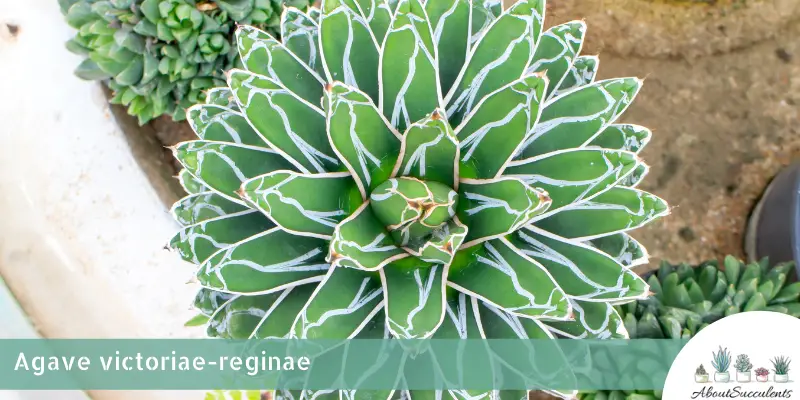
Agave Victoriae- reginae is a breathtakingly beautiful succulent plant that will undoubtedly make your outdoor garden or any living space in your home an instant standout.
The most striking feature of this succulent which also goes by the common names ‘Queen Victoria Century Plant’, ‘Queen Victoria Agave’, and ‘Royal Agave’ is its emerald green leaves.
The white markings that can be found on the surface and margins of each leaf appear to be painted by hand. The leaves are thick, spineless, and long – growing to a maximum length of 7 inches (20 cm) – and forming a spherical rosette.
Royal Agave will take 10 years to flower. When it does, you’ll notice a tall flowering spike that can reach a height of 15 feet (4.5 m). Queen Victoria Agave will produce small clusters of creamy white flowers but will die shortly thereafter.
Unsurprisingly, Agave Victoriae- reginae was bestowed the Award of Garden Merit by the Royal Horticultural Society. This award-winning succulent is best planted in pots in regions that experience freezing temperatures.
2. Sempervivum ‘Mark Weller’
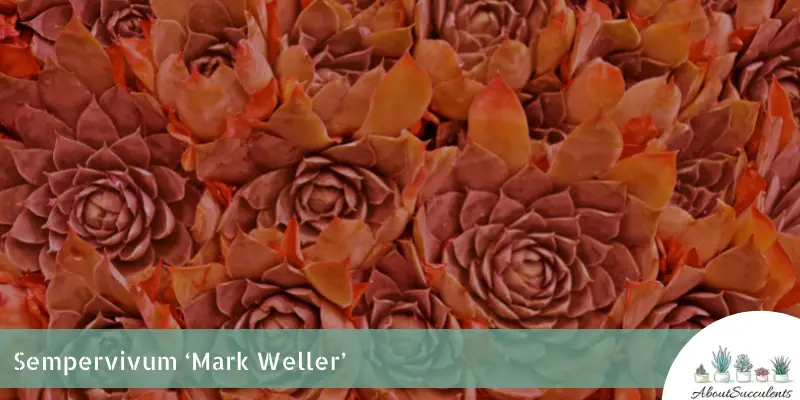
Sempervivum ‘Mark Weller’ is a charming succulent that can only grow to a maximum height of 3 inches (7.62 cm) and the leaves form a tight rosette that can spread as far out as 6 inches (15.24 cm).
Mark Weller’s most distinguishing feature is its leaves that start out dark green and are accented by pink-tinged tips. When given regular exposure to direct sunlight, the leaves will change colors and assume different hues – gold, violet, or light pink.
Common names for Mark Weller are ‘Hens and Chicks’ and ‘Houseleeks’ because the succulent produce offsets that you can use for propagation. The offsets are a ‘parting gift’ because Mark Weller is monocarpic and dies after blooming pink-orange flowers in the late spring or early summer.
Another wonderful quality of Mark Weller is that it can tolerate temperature drops as low as -30° F (-34.4° C). You can grow Hens and Chicks in a pot and showcase an elegant succulent wonderland in the garden during Christmas.
3. Aeonium Canariense
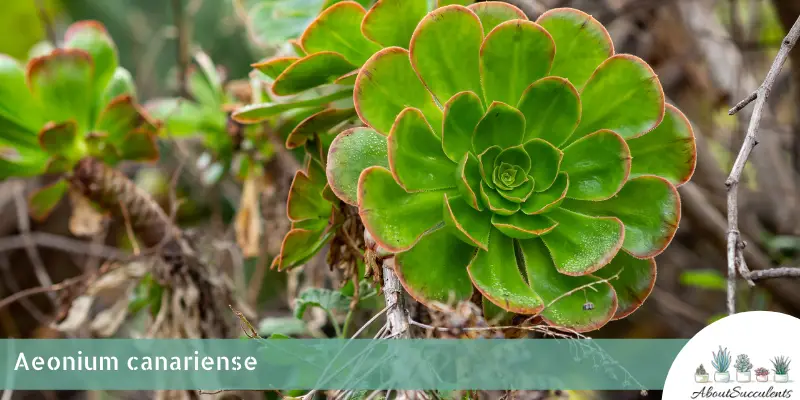
Aeonium Canariense is a mesmerizing succulent that attracts impressed sets of eyes as well as butterflies.
Also known as ‘Canary Island Aeonium’, ‘Giant Velvet Rose’, and ‘Mint Saucer’, its flat, thick, and paddle-shaped leaves have a velvet-like texture. Canary Island Aeonium’s leaves start out as emerald green but when exposed to full sun for 6 hours every day, the leaves will change color to reddish-pink.
It takes a long time for Giant Velvet Rose to bloom. But when it finally does, Mint Saucer will produce small, yellow-colored, and star-shaped flowers that sit atop a 3-foot (90 cm) long stem.
As a monocarpic succulent, Aeonium canariense will die after blooming. Fortunately, the succulent will leave you with offsets that you can use to propagate your next collection of Aeonium.
Giant Velvet Rose isn’t a cold-hardy succulent and is best planted in a pot if your region gets colder than 20° F (-6.7° C).
4. Echeveria ‘Neon Breakers’
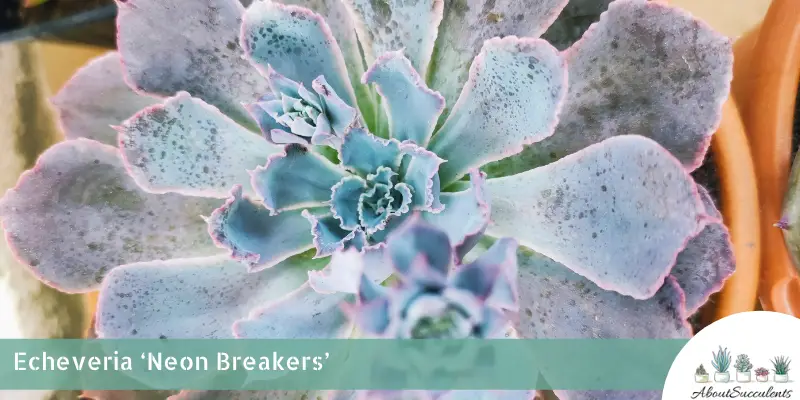
Echeveria ‘Neon Breakers’ is a winsome succulent that only grows to a height of 3 inches (7.6 cm) but what it lacks in size, it more than makes up in color.
The frilly leaves of this variety of Echeveria start out as having a bluish color with pink margins and tips. As it matures and gets more full sun exposure, the leaves assume a royal purple color.
Another name for Echeveria neon breakers is Hens and Chicks because it produces offsets. Gently pull out the offsets that grow near the base of the plant. Choose the larger-sized offsets to assure you of successful propagation.
From late summer to early spring, Hens and Chicks will produce alluring flowers that start out with a light pink color. As the plant matures, the flowers turn into darker shades of pink.
Echeverias are known to be highly tolerant of drought but not of frost. If the mercury drops below 30° F (-1.1° C), it would be best to grow neon breakers in a terracotta pot and use it to adorn your indoors.
5. Graptosedum ‘Alpenglow’
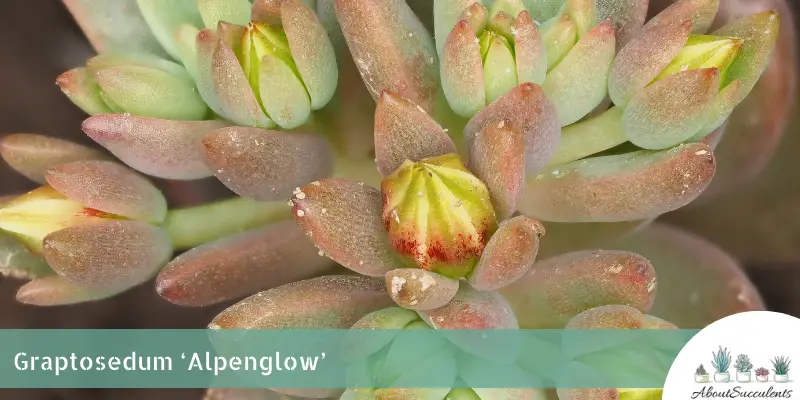
Graptosedum ‘Alpenglow’ is a majestic succulent that’s sought after for its thick, fleshy, and banana-shaped leaves that start out as green and turn into different shades of pink as it matures.
Another name for Alpenglow is ‘Twilight’ because its tight, compact, and pink-hued rosettes remind many people of a beautiful sunset. In the summertime, Twilight blooms small, yellow-colored, and star-shaped flowers.
Alpenglow isn’t a big succulent and that makes it ideal to grow in pots. This hybrid of Graptopetalum and Sedum will only reach a maximum height of 8 inches (20 cm) and spread out to 12 inches (30.5 cm).
Twilight is also not a cold-hardy succulent. Plant Alpenglow in a pot and transfer it indoors when temperatures in your area fall below 30° F (-1.1° C).
Conclusion
While succulents can be planted directly in the ground, there are a good number of reasons to grow them in pots.
For types of succulents that aren’t tolerant of frost – and there are quite many – growing them in pots will make it easier for you to move your beloved plants indoors when temperatures drop below freezing.
Similar to succulents, you can buy pots in different colors, shapes, sizes, and textures. Potted succulents will look great in a rock garden and container garden.
Last Updated on décembre 20, 2022 by Sofia Lara